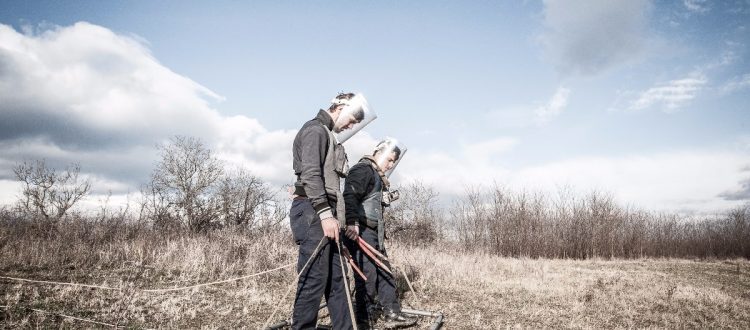Buried conflict – explosive remnants of war in Kosovo
Hekuran and Agron keep fighting for a mine-free Kosovo. Through long stretches without adequate support and funding, through rainfall and snow shifting the sediment of buried mines, through winter, summer, spring and fall, they continue ridding Kosovo’s soil of this memory of the conflict.
| Suggested Reading | Collaborate | GCCT |
By Brenna Gautam
“Never cross the red marker sticks; inside is the minefield, outside is the cleared area. Never pick up anything in the minefield. Never throw anything in the minefield. Always listen to the instructions of the team leader.”
I stand at the edge of a forested mountain pass in southern Kosovo, fidgeting beneath my bomb-proof vest as sweat rolls down from beneath the protective visor covering my face. My team leader, Hekuran Dula of The Halo Trust, provides the safety training in calm, professional tones while I take frantic, sprawling transcriptions in a spiral bound notebook. Hekuran tells me that the minefield we stand at today was once a strategic access point for both Serbian forces and the Kosovo Liberation Army. Hence, it is littered with explosives.
The fighting in Kosovo has been over for nearly two decades; it is 2017, and Kosovo gained its independence in 2008. During my most recent stay in the capital city, Pristina, residents seemed eager to put the narrative of a war-torn nation behind them, showcasing instead their burgeoning art shows, documentary festivals, coffee shops, and office spaces. Their national monument is called “Newborn,” and their population is young, concerned more with their economic future than with the trauma of their collective past.
The fighting has been over for eighteen years, and yet I hesitate to write that the conflict in Kosovo is over, because it is 2017 and still weapons of war pose a risk to innocent civilians. The team at Halo Trust has lost one of their own to those weapons.
When Hekuran speaks of any mine-related accident, his voice grows rough and quiet, and I am struck by how deeply personal this work is. How those whose lives intersect with buried explosives are without exception touched by the pain and loss of war itself.
De-miners like Hekuran have been operating on a nearly daily basis since 1999. Yet despite almost two decades of work, there remain over one hundred “Dangerous Areas” in Kosovo, each containing acres of unexploded ordnance. According to Kosovo Mine Action Centre, in 2016 alone, 88,778 explosive items were found and destroyed.
What is a landmine? What is a cluster bomb? I had a general knowledge of these weapons before coming to Kosovo, but only a dry, textbook understanding. I had briefly studied the Ottawa Treaty, an international agreement to ban landmines, in college (it was presented as well-intentioned but controversial, ineffective, and naïve). In a seminar on the law of armed conflict, a professor taught me that unnecessary suffering is a balancing equation between human suffering and the military advantage to be gained.
Hiking through the former battlefields of Kosovo, I try to balance the stories I’ve been told with the reality I face: that de-miners and mine victims are far from the only people affected by the buried remains of this conflict.
Cattle and other animals wandering into minefields have huge economic ramifications for Kosovar families whose wealth lies in their livestock. Large swaths of land used for agriculture or tourism have been temporarily shut down for mine clearance, resulting in further economic loss. When found near schools, education has been disrupted by these weapons. Whole irrigation systems are impacted by the buried ordnance.
How can you measure the proportionality of military advantage to civilian loss when the military advantage is fleeting, and the harm to civilians so long-lasting?
Moreover, how can you measure the psychological harm that comes from not being able to trust the ground itself? During my trips to the field, I experienced the choking anxiety of realizing that even a slight wrong move could kill myself and injure those around me.
It’s difficult to imagine that anxiety played out indefinitely, as civilians try to go about their daily lives while ignoring the skull and crossbones of warning signs nailed to nearby trees. In Kosovo, the sword of Damocles does not hang over their heads; it is buried beneath their feet.
On my last day in Kosovo this summer, I took an afternoon stroll through Gërmia National Park. Gërmia is perfect for a summer afternoon—gentle hills, pine trees, athletic fields, a glistening swimming pool—but it was not always so idyllic. The last time I stayed in Kosovo, four years prior, much of the park was roped off due to minefields.
Mr. Agron Heziri, head of the Kosovo Mine Action Centre, told me that the Gërmia site was declared officially mine-free on his birthday. Like Hekuran, Agron is deeply connected to his work and seems to celebrate the victory of a cleared field as a triumph on both a national and personal level. Each acre cleared is progress.
It makes me hopeful and grateful that people like Hekuran and Agron keep fighting for a mine-free Kosovo. Through long stretches without adequate support and funding, through rainfall and snow shifting the sediment of buried mines, through winter, summer, spring and fall, they continue ridding Kosovo’s soil of this memory of the conflict.
I wish these remains had not been buried there in the first place. But the catharsis of watching un-cleared land become safe again through cooperation and care feels a little like conflict transformation in action. Kosovo may still live with its buried conflict, but there is hope here for a better future.
Brenna Gautam is currently a student at the Georgetown University Law School, hoping to specialize in international law and nonproliferation.
The views expressed in this article do not necessarily reflect those of TransConflict.



















